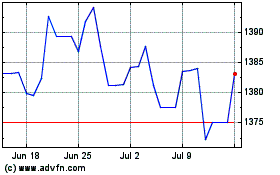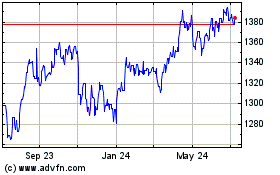Most Southeast Asian Currencies Drop Against Dollar
October 21 2009 - 12:13AM
RTTF2
Wednesday, most Southeast Asian currencies declined against the
U.S. dollar on the back of weak Asian equities. The South Korean
won plunged to a 3-week low and the Indian rupee fell to a 9-day
low.
Meanwhile, the currencies of Singapore, Thailand, Malaysia and
Taiwan slumped to 2-day lows.
On the other hand, the Pakistan rupee soared to a 6-day high
against the dollar and the Philippine peso recovered from a 2-day
low against the dollar.
Asian markets are trading lower today with the negative close on
Wall Street overnight on weak economic reports hurting sentiment to
an extent. Profit taking after recent gains is also contributing to
the weakness in the region. Despite bouncing back after an early
setback, some of the markets are seen struggling to hold at higher
levels due to lack of support.
The U.S. Commerce Department reported yesterday that housing
starts rose by much less than economists had expected in the month
of September. Housing starts rose by 0.5 percent to an annual rate
of 590,000 in September from the revised August estimate of
587,000. Economists had expected starts to rise to 610,000 from the
598,000 originally reported for the previous month.
Additionally, the report showed that building permits, an
indicator of future housing demand, fell 1.2 percent to an annual
rate of 573,000 in September from the revised August rate of
580,000. The drop in building permits came as a surprise to
economists.
Also, the Labor Department revealed that producer prices fell
0.6 percent in September, while economists were looking for
producer prices to slip by 0.3 percent. Core prices, which exclude
the volatile food and energy sectors, edged down by 0.1 percent for
September, while economists had anticipated an increase of 0.1
percent.
Yesterday's economic news largely extinguished optimism that
came following a string of positive earnings reports from corporate
stalwarts Apple (AAPL), Caterpillar (CAT) and Texas Instruments
(TXN), among others.
After a brief uptrend, the Singapore dollar declined against the
US currency in early Asian deals on Wednesday. The pair moved from
1.3941 to 1.3976 at 10:10 pm ET. This set a 2-day low for the
Singapore dollar. On the downside, 1.399 is seen as the next target
level for the Singapore dollar. At yesterday's close, the pair was
quoted at 1.3956.
During early Asian trading on Wednesday, the Thai baht declined
to a 2-day low of 33.53 against the U.S. dollar. The next downside
target level for the Thailand currency is seen at 33.695. The
dollar-baht pair was worth 33.4250 at yesterday's close.
The Malaysian ringgit that closed yesterday's trading at 3.3675
against the US dollar fell to a 2-day low of 3.40 in early Asian
deals on Wednesday. If the Malaysian currency drops further, it may
target the 3.420 level.
The Philippine peso that slipped against the dollar in early
Wednesday Asian deals reversed direction after hitting a 2-day low
of 47.27 at 9:40 pm ET. At present, the dollar-peso pair is worth
46.49, compared to yesterday's closing value of 46.61. If the
Philippine peso advances further, it may target the 46.25
level.
In early Asian trading on Wednesday, the South Korean won
plummeted to a 3-week low of 1184.10 against the US dollar. The
next downside target for the Korean currency is seen at the 1189
level. The dollar-won pair closed yesterday's deals at 1161.10.
Wednesday, the Indian rupee opened lower against the US dollar.
Currently, the rupee is trading at a 9-day low of 46.5350 per
dollar with 46.685 seen as the next target level. The dollar-rupee
pair closed yesterday's deals at 46.1250.
The Pakistan rupee that closed yesterday's trading at 83.35
against the US dollar strengthened to a 6-day high of 82.86 in
early deals on Wednesday. If the Pakistan currency rises further,
it may target the 82.76 level.
In early Asian trading on Wednesday, the Taiwan dollar slumped
to a 2-day low of 32.3870 against the US currency. The next
downside target level for the Taiwan dollar is seen at 32.40. The
pair was worth 32.2850 at Tuesday's close.
Looking ahead, Malaysia will provide consumer price index data
for September. Analysts are expecting the rate to decline 2 percent
on year following the 2.4 percent annual contraction in the
previous month.
Meanwhile, the Thailand central bank is scheduled to announce
its interest rate decision. Analysts expect the bank to keep rates
on hold at the current 1.25%.
Thailand will also release imports, exports and trade balance
report for September. Exports are seen lower by 15.9 percent on
year following the 18.4 percent annual decline in August. Imports
are called lower by 27.8 percent on year after the 32.8 percent
annual contraction in the previous month. The trade balance is
predicted to show a surplus of $2.29 billion after posting a $2.08
billion surplus a month earlier.
The U.S. Federal Reserve is due to release its Beige Book, which
is a compilation of anecdotal evidence on economic conditions from
each of the 12 Federal Reserve districts, at 2 pm ET. The report is
normally released about two weeks before the monetary policy
meeting is held.
US Dollar vs KRW (FX:USDKRW)
Forex Chart
From Mar 2024 to Apr 2024

US Dollar vs KRW (FX:USDKRW)
Forex Chart
From Apr 2023 to Apr 2024
